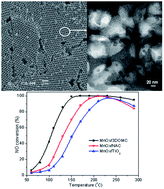Highly dispersed MnOx nanoparticles supported on three-dimensionally ordered macroporous carbon: a novel nanocomposite for catalytic reduction of NOx with NH3 at low temperature†
Abstract
In this paper, we report a novel nanocomposite of MnOx nanoparticles supported by three-dimensionally ordered macroporous carbon (MnOx/3DOMC) fabricated by means of a simple multi-component infiltration of three-dimensional templates and its use as a catalyst for low-temperature selective catalytic reduction (SCR) of NOx with NH3. Several techniques, including scanning electron microscopy, X-ray diffraction, N2-sorption, transmission electron microscopy, X-ray photoelectron spectroscopy, NH3 temperature-programmed desorption, and H2 temperature-programmed reduction, are employed to characterize the MnOx/3DOMC nanocomposite. The results demonstrate that MnOx/3DOMC possesses a highly ordered macroporous structure with hierarchical mesopores in the walls of the macroporous skeleton. MnOx nanoparticles of 2–4 nm are observed to be highly dispersed on the 3DOM carbon scaffold. Compared with the MnOx/NAC and MnOx/TiO2 catalysts prepared by a conventional impregnation method, the MnOx/3DOMC catalyst exhibits better low-temperature NH3-SCR activity, stability, and water vapor and/or SO2 resistance ability. Such material represents a promising exploratory direction for enhancing the catalytic performance of metal oxide-based NH3-SCR catalysts.


 Please wait while we load your content...
Please wait while we load your content...